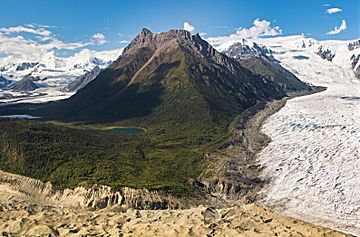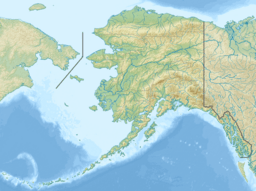Donoho Peak facts for kids
Quick facts for kids Donoho Peak |
|
|---|---|

Donoho Peak, south aspect
|
|
| Highest point | |
| Elevation | 6,696 ft (2,041 m) |
| Prominence | 1,496 ft (456 m) |
| Isolation | 3.68 mi (5.92 km) |
| Parent peak | Bonanza Peak |
| Geography | |
| Location | Wrangell-St. Elias National Park Valdez-Cordova Borough Alaska, United States |
| Parent range | Wrangell Mountains |
| Topo map | USGS McCarthy C-6 |
| Geology | |
| Age of rock | Cretaceous |
| Type of rock | Greenstone, Limestone |
| Climbing | |
| Easiest route | Scrambling, Glacier crossing |
Donoho Peak is a tall mountain in Alaska, standing 6,696 feet (2,041 meters) high. It's part of the Wrangell Mountains and is located inside Wrangell–St. Elias National Park and Preserve. This park is a huge area of protected land.
The mountain is about 6 miles (10 km) northwest of a historic mining town called Kennecott. It's also 9 miles (14 km) north of McCarthy. Donoho Peak sits where two large ice rivers, the Kennicott Glacier and Root Glacier, meet. The name "Donoho Peak" was officially recorded in 1931.
The mountain is in the area where water flows into the Copper River. You might even spot bears around Donoho Peak and the nearby Donoho Lakes!
If you wanted to climb Donoho Peak, it's a 14-mile round trip from Kennecott. The climb involves walking across the Root Glacier and then scrambling up a rocky gully on the south side of the mountain. There are old ruins of the Regal Mine at 5,440 feet (1,658 meters) on the mountain's south slope. This mine didn't produce much copper, though. From the top of Donoho Peak on a clear day, you can see amazing views of Mount Blackburn and the Stairway Icefall on Regal Mountain.
Weather at Donoho Peak
Donoho Peak has a subarctic climate. This means it has very long, cold, and snowy winters. The summers are usually cool.
The weather systems from the Gulf of Alaska hit the Wrangell Mountains. This forces the air upwards, which causes a lot of rain and snow to fall. This process is called orographic lift. Temperatures can drop very low, sometimes below −20 °C (−4 °F). With the wind, it can feel even colder, below −30 °C (−22 °F). The best time to visit or climb Donoho Peak is usually from May through June, when the weather is most pleasant.
How the Mountain Formed
Donoho Peak and the ridge connected to it separate two large glaciers: Gates Glacier and Root Glacier. The rocks here show layers from the Triassic and Jurassic periods. These layers are part of something called the Wrangellia Terrane. This is a large piece of Earth's crust that moved over time.
On top of these older rocks, there are newer layers from the Miocene period, like the Frederika Formation and the Wrangell Lava. The mountain itself has a cool geological feature: an overturned fold called a syncline. This fold is made of Nizina limestone and looks like a gray zigzag pattern on the east side of the peak.
Images for kids









